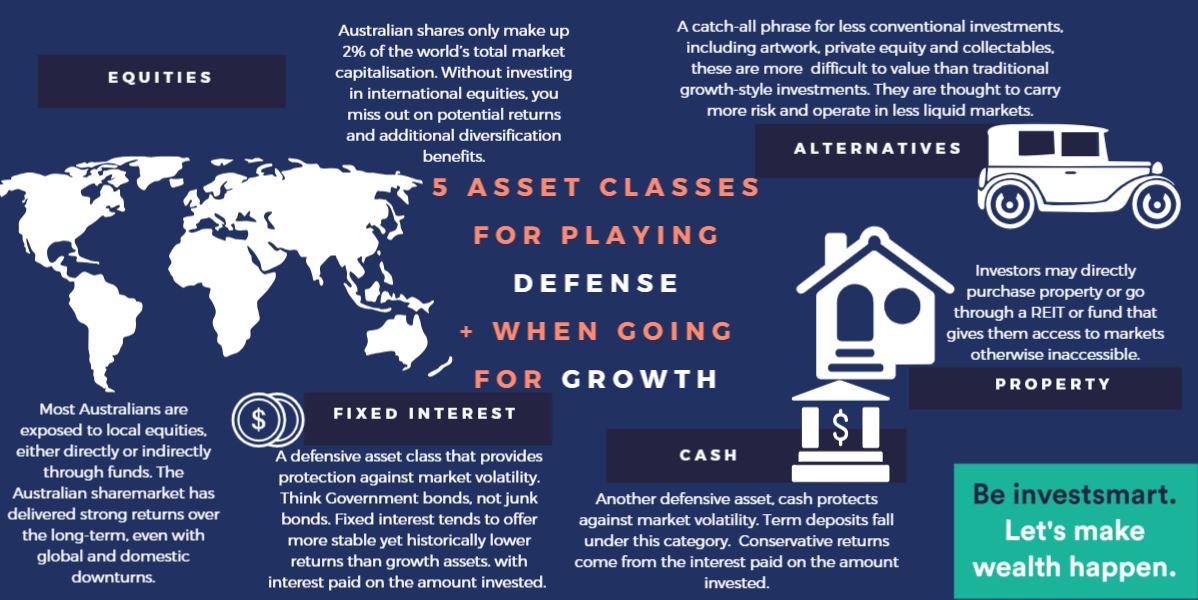Understanding Asset Allocation
Once you know your objectives, your time horizon and your risk profile, you can then determine asset allocation. Your investing goal should be maintaining a diversified portfolio, and achieving this means allocating different amounts across different asset classes including equities, fixed interest, property, alternatives and cash. All the while, you should keep your life cycle stage, current situation and goals top of mind.
Don’t put all your eggs in one basket
At some stage, that basket is bound to crack.
Over the long-term, no singular asset class is guaranteed to deliver consistent returns. This makes diversification important.
Unfortunately, when it comes to investing, most Australians will focus on their home turf only and overlook opportunities abroad. Therefore, it’s nothing personal when we say Australians tend to be ‘overweight’ domestic equities, property and cash, and ‘underweight’ international markets. If Australia has such a strong economy, why does this even matter? Well, volatility and downturns are par for the course in any market, and you’re probably always missing out on better gains to be experienced elsewhere.
Over the past 70 years, every single asset class has experienced a period of outperformance against its peers, before encountering a setback to underperform. It’s natural for markets to have winners and losers. It’s difficult to pick these. Some eggs will hatch golden, and others rotten.
Keeping several baskets, or diversifying across asset classes, will ultimately reduce risk, improve returns and preserve wealth.
But how do I pick the baskets?
Of course, what works for some won’t work for all.
Asset allocation will depend on your risk profile and objectives, and your personal goalposts are forever changing. That’s why reviewing and rebalancing your portfolio on a regular basis is necessary.
For example, as a younger investor, you may have a longer horizon to achieve your goals, and therefore, years to endure volatility. Growth assets will probably be more your thing. You can probably afford to win some and lose some, and take on more risk. But as an older investor, you should probably be a little more conservative and lean on defensive assets, as you’re more than likely relying on your savings for income.
Growth v Defensive
In this battle, it’s impossible to pick a consistent winner. Keep the company of both.
Traditionally, defensive assets are lower risk and lower return. Think cash, fixed interest and some equities. Volatility isn’t in their nature. In all hope, they provide a regular and steady income stream, while preserving principle. In a down market, they tend to do better. Above all though, easy does it with defensive assets, and they are more about preserving wealth than going for growth.
That’s where growth assets kick in, like equities, property and alternatives. Growth assets generally outperform in up markets, and they should ultimately provide returns in the form of something called capital growth. Over time, the value of the asset should ultimately go up – but it may be a rocky road along the way.
Tailwinds are great, headwinds not so. Getting the right balance of defensive and growth assets is important, and it will all depend on your risk tolerance and objectives.
A balancing act
If it’s backed by a Nobel Prize winning economist, you know the theory must be good.
Harry Markowitz developed Modern Portfolio Theory in 1952 to demonstrate how you can combine different assets with different volatilities to minimise overall portfolio volatility. It still holds up today.
Correlation is the name of the game here. You should choose assets with low correlation, so when one asset goes down, the other is more likely to go up. The golden egg outshines the rotten egg. Determining the exact balance is a personal matter, but this way, the balance of your portfolio should ultimately be in your favour.

Frequently Asked Questions about this Article…
Asset allocation involves distributing your investments across various asset classes like equities, fixed interest, property, alternatives, and cash. It's crucial because it helps diversify your portfolio, reducing risk and potentially improving returns over time.
Diversification spreads your investments across different asset classes, which can reduce risk and improve returns. By not putting all your eggs in one basket, you protect your portfolio from the volatility of any single asset class.
Australian investors often focus too heavily on domestic equities, property, and cash. By considering international markets, you can take advantage of opportunities abroad, potentially experiencing better gains and reducing the impact of local market downturns.
As a younger investor, you might focus more on growth assets like equities and property, as you have time to ride out volatility. As you age, shifting towards defensive assets like cash and fixed interest can help preserve wealth and provide steady income.
Growth assets, such as equities and property, aim for capital growth and perform well in up markets. Defensive assets, like cash and fixed interest, are lower risk and provide steady income, performing better in down markets.
The right balance depends on your risk tolerance and investment goals. Regularly reviewing and rebalancing your portfolio can help maintain the desired mix, ensuring it aligns with your changing objectives and market conditions.
Modern Portfolio Theory, developed by Harry Markowitz, suggests combining assets with different volatilities to minimize overall portfolio risk. By choosing assets with low correlation, you can balance your portfolio, potentially enhancing returns while reducing risk.
Regularly reviewing and rebalancing your portfolio ensures it remains aligned with your risk profile and investment goals. As markets and personal circumstances change, adjustments may be necessary to maintain the desired asset allocation and optimize returns.

















